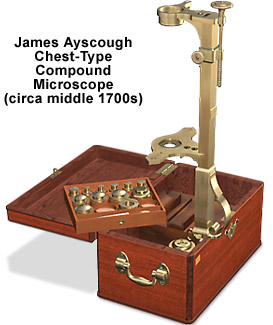James Ayscough Chest-Type Microscope
Built by London instrument designer James Ayscough in the middle portion of the eighteenth century, this Cuff-style microscope was assigned a serial number of 26 after being manufactured. Gerard Turner has described the construction and history of this microscope in fine detail.

James Ayscough was in business in the St Paul's portion of London between 1740 and 1759, and made a number of microscopes bearing this style. The split side-pillar, reminiscent of Cuff-style microscopes, has an iron fine focus screw that secures the missing body tube. Presumably, the brass body tube was fashioned in a manner similar to the popular Cuff microscope, a predominant design of the period.
The integral wooden base is utilized to support the microscope pillar and to house a host of accessories in a series of drawers. The bottom portion of the pillar is secured in a bracket positioned near one corner of the wooden base. A fixed stage contains two wings for attaching a fish-plate and has a bull's-eye lens. A substage plano-concave mirror can be mounted in the base on a pillar having a brass boss.
A number of accessories are included in the mahogany chest (base), all housed in a series of three drawers. The uppermost drawer contains stage components including a bull's-eye lens, fish-plate, forceps, and the mirror. A second drawer is designed to hold the objectives and Lieberkuhn reflectors, while the bottom drawer houses a brass wet cell, glass strip, specimen holder, and light-limiting cone.
Like similar microscopes, fine focus is achieved with a thumbscrew that moves the brass body tube housing in relation to the rectangular brass pillar. Course focus adjustments are made by translating a brass boss (holding the fine focus thumbscrew) upward or downward on the pillar.
BACK TO EIGHTEENTH CENTURY MICROSCOPES
